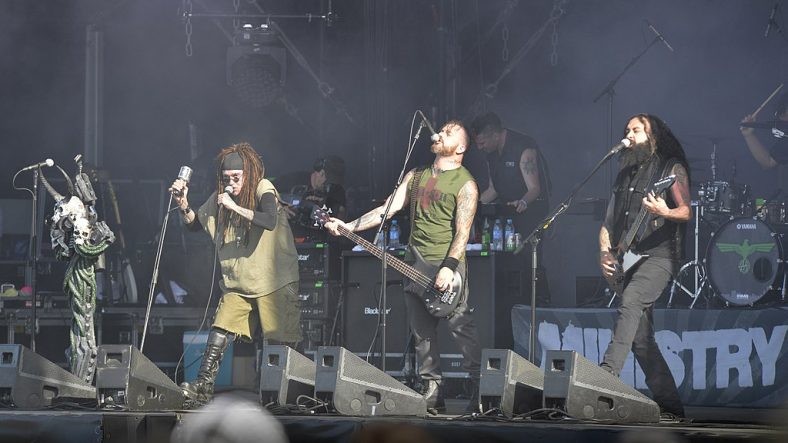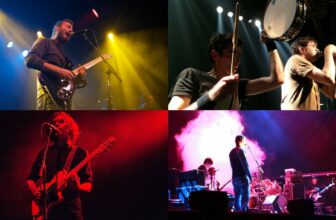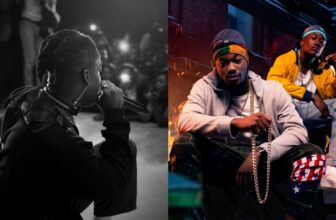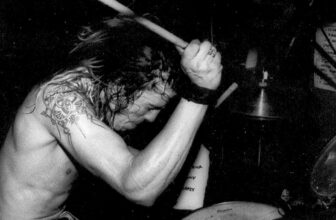What Is Industrial Music?

Industrial music is a music genre that incorporates harsh and heavy themes and sounds. Music critics often describe it as the most abrasive combination of electronic and rock music. Industrial music first appeared in the 1970s.
Contents
Why Is It Called Industrial Music?
The term “Industrial Music” was coined for this style of music in reference to a British label called “Industrial Records.” Industrial Records was founded in 1976 by Throbbing Gristle, a band credited for inventing industrial music.
History of Industrial Music: A Quick Look
Industrial music can be noticed in releases dating back to the 1970s, particularly in the works of Throbbing Gristle, Nurse With Wound, Cabaret, Voltaire, and SPK.
Most of these groups were based in the USA and UK. Their motivation to explore what cutting-edge keyboard synthesizers and drum samplers were capable of was the primary catalyst that led to the formation of industrial music.
The British record label “Industrial Records” and the American record label “Wax Trax” were often associated with industrial music acts.
Wax Trax got a strong reputation following the releases of Revolting Cocks, Ministry, and other groups. All of these were founded by the same artist: AI Jourgensen.
Ministry’s music, in particular, was the most influential. Their music influenced acts like Rammstein, Marilyn Manson, and many more.
But how did industrial music turn mainstream? Well, most scholars agree that Nine Inch Nails’ industrial music albums were responsible for taking the genre from the underground to the mainstream. Their music was a combination of synthpop beats, goth aesthetics, and post-punk emotions.
Despite its provocative and transgressive themes, the genre managed to achieve widespread popularity. Nine Inch Nails managed to claim several Grammy awards for their industrial music albums.
How Do You Define Industrial Music?
According to Allmusic, industrial music is considered the most aggressive combination of electronic and rock music. Here are some of its characteristics:
Heavy Use of Technology
One of the elements that distinguish industrial music from other music genres is the embrace of technology. The pioneers of industrial music used the most advanced and expensive samplers and synths to produce their music.
Pop Hooks
Some industrial music groups incorporated tropes of pop music into their music. It wasn’t common since most industrial music groups opposed commercialism.
For instance, bands such as Einstürzende Neubauten and Psychic TV added new wave melodic hooks to their music in the 1980s. In the 1990s, many artists fused heavy metal and hard rock with industrial music.
Disturbing Lyrics and Themes
Industrial music works often include controversial lyrics and themes that oppose society’s cultural values. Examples encompass mutilation, torture, and sexual deviance.
What Are the Instruments of Industrial Music?
Industrial music uses instruments in unconventional ways. Many industrial music artists like Ministry and Nine Inch Nails combined samplers and synthesizers with heavy drums and distorted guitars from heavy metal to create a unique sound.
One of the bands that emphasized this was Cabaret Voltaire. Kirk used a customized fuzzbox that Watson built to create his signature timbre with his guitar, while Tutti integrated a slide with his guitar to produce glissandi.
Some artists also struck the strings of the guitar to use it as a percussion instrument.
Types of Industrial Music
Over the years, industrial music has evolved drastically into numerous types. Here are some of the most prominent styles and subgenres of industrial music:
Electronic Body Music
Electronic Body Music (EBM) is a subgenre of industrial music that focuses on eccentric themes, repetitive basslines, distortion-free vocals, and programmed dance music rhythms.
The term “Electronic Body Music” was first used in 1977 during Ralf Hütter’s (of Kraftwerk) interview with WKSU radio. However, the subgenre only became relevant in the late 1980s.
Some notable EBM musicians include Ionic Vision, Suicide Commando, and Spetsnaz.
Electro-Industrial
Electro-industrial music is vastly similar to electronic body music. The only area where they differ is structure. Instead of using a minimal structure, electro-industrial music relies on complex and experimental structures.
What’s more, electro-industrial music integrates aggressive beats complemented by distorted vocals.
Some examples of this style of industrial music include works by Front Line Assembly, SPK, Borghesia, Skinny Puppy, and Numb.
Dark Ambient
Dark ambient is a style of industrial music that appeared in the 1990s, particularly with the release of works of the record label Cold Meat Industry. However, dark ambient has roots back in the 1970s, particularly when synths and samplers were smaller and cost less.
The subgenre incorporates catacomb-like atmospheres and gloomy droning. You can notice these elements in early works from the 1970s, like the double-album Zeit from David Lynch’s Eraserhead and Tangerine Dream movie. Another notable example is Throbbing Gristle’s 1970 album D.o.A.
Industrial Hip-Hop
Industrial hip-hop is a fusion genre that combines elements of industrial music and hip hop, along with dub music.
This style of music began to appear in the 1980s. It’s most notable in releases featuring artists like Mark Stewart and Bill Laswell. It’s characterized by distorted drums, aggressive vocals, blaring, and dissonant noise. It featured repellent themes such as BDSM, cults, and sexual abuse.
Albums by Dälek, Techno Animal, and Saul are considered the most aggressive form of industrial hip-hop.
Power Electronics
Loud static, distorted lyrics and feedback waves are among the strongest factors distinguishing power electronics as a music genre.
It’s also known to be atonal. In other words, the music pieces that can be characterized as power electronics barely include any melodies or rhythms.
Psychopathia Sexualis by Whitehouse contained the earliest presence of power electronics. Some notable power electronics artists include Brighter Death Now, Ramleh, Philip Best, Genocide Organ, and Sutcliffe Jügend.
Industrial Rock
Industrial rock is a fusion genre that borrows elements from rock ‘n’ roll and industrial music. It’s characterized by electronic music, distorted guitars, bass guitars, and drums, along with controversial and provocative lyrical themes.
Its roots date back to the first few years of the 1970s. It can be heard in performances by Chrome, Einstürzende Neubauten, and Throbbing Gristle. It had a strong presence in the 1980s, too, particularly in acts such as Swans and Killing Joke.
Japanoise
As its name implies, Japanoise is simply “Japan” and “Noise” combined. This subgenre is all about musical freedom.
The lyrics often revolve around sensitive topics like war and BDSM, particularly due to its power electronics influences.
Japanoise is defined by electronics, dissonance, and disturbing topics. Merzbow and Hanatarash are among the most well-known Japanoise artists.
Witch House
Witch house falls under the umbrella of both industrial and electronic music. It’s defined by altered vocals, transgressive lyrics, and dark themes.
This style of music relies heavily on visual aesthetics, too. Witch house artists usually incorporate occult, witchcraft, and terrorizing artworks with their albums.
The subgenre is relatively new, and the term wasn’t coined until 2009. It’s also worth noting that Witch House includes photographs that contain unsaid words and hidden messages.
Neofolk
Neofolk is a fusion genre that draws influences from punk rock, industrial music, and experimental folk music. It usually uses themes such as occultism, heathenry, fascist symbolism, and neopaganism.
While this style of music is widely known as neofolk, another popular name for it is apocalyptic folk. Ernst Jünger’s book, “The Forest Passage (Waldgäng),” is a vital source of ideas for neofolk artists.
Neofolk pieces date back to the 1980s, specifically after the abundance of punk rock circles.
Popular Industrial Music Artists
There are lots of industrial music artists on the scene, but only a few gained worldwide fame and popularity. Here are some of the most notable industrial music artists:
Nine Inch Nails
Nine Inch Nails is a Cleveland-based band that started in 1988. Their “The Downward Spiral” and “The Fragile” albums, released in 1994 and 1999, were huge successes.
In addition, their hit songs “Wish” and “Happiness in Slavery” won them 2 Best Metal Performance awards in 1992 and 1996.
According to AllMusic’s Steve Huey, the rise of Nine Inch Nails was a major contributing factor to the widespread popularity of industrial music.
Skinny Puppy
Skinny Puppy is a Canadian Industrial music band founded in Vancouver in 1982. They’re one of the founding groups of industrial music, particularly in Canada.
By drawing influences from Chrome, Fad Gadget, Throbbing Gristle, SPK, and others, the band’s sound has a remarkable “sound sculpturing” effect.
In their early releases, they used analog and digital recording methods. They also utilized drum machines, synths, samplers, tape loops, and rock music instruments.
Marilyn Manson
Marilyn Manson is a singer and songwriter from Ohio. In 1989, he founded the band of the same name in cooperation with guitarist Daisy Berkowitz.
His real name is Brian Hugh Warner, which makes people wonder where he got his stage name from.
Well, he formed his name by combining the names of Marilyn Monroe and Charles Manson. The whole point is that the two are opposing cultural icons, with Marilyn being a sex symbol and Manson being a criminal.
Ministry
Ministry is an industrial music band founded in Chicago in 1981. The band gained significant recognition in the late 1980s thanks to their albums “Twitch,” “The Land of Rape and Honey,” and “The Mind Is a Terrible Thing to Taste.”
These three albums translate the band’s shift from synthpop to industrial music, cementing their position among the pioneers of the genre.
Throbbing Gristle
Throbbing Gristle is widely considered by fans and critics as the pioneer of industrial music. Their debut single “United/Zyklon B Zombie” and debut album “The Second Annual Report” were released in 1977.
They were widely known for including disturbing lyrical themes revolving around society’s underground aspects, mysticism, and sexuality.
The group was based in Kingston upon Hull in the UK.
Summary
So that was a brief overview of industrial music and its history, subgenres, and characteristics.
Even though industrial music is less popular today, many artists and bands are still keeping the gears grinding, including Chrome, Corpse, 3Teeth, The Named, Sally Dige, and The Ugly Facade.
Ministry Featured Image by: Selbymay, CC BY-SA 4.0 <https://creativecommons.org/licenses/by-sa/4.0>, via Wikimedia Commons





